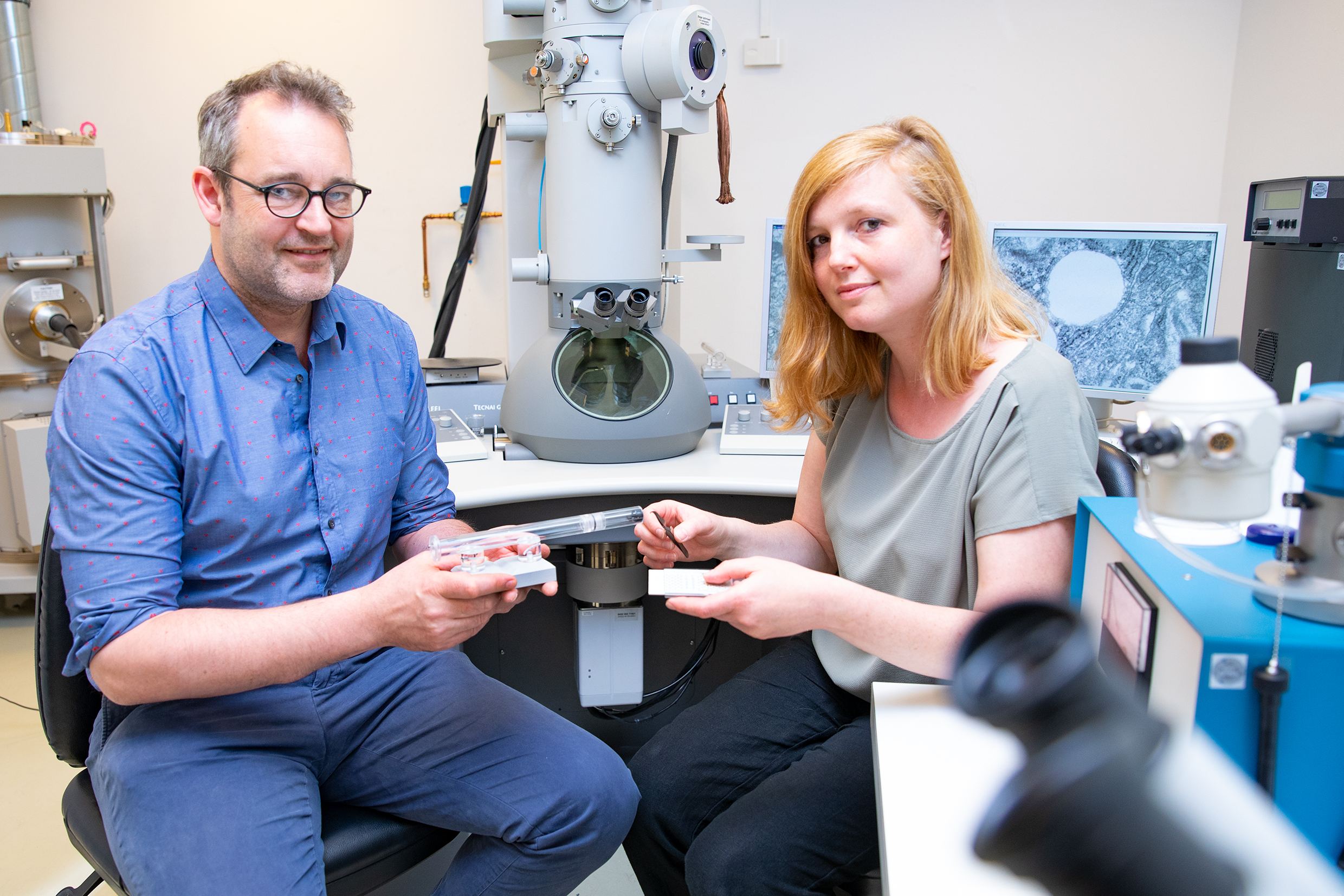For the first time, a team of scientists clearly demonstrates the existence of lipofibroblasts in human luectron microscope

Dr Julia Schipke and Professor Christian Mühlfeld in front of an electron microscope; Copyright: Karin Kaiser / MHH.
07.07.2021
In medical research, animal models are used to clarify the development of diseases and to develop suitable therapies. In order to be able to transfer the results to humans, however, it must be ensured that the cell types and molecular signalling pathways studied in detail actually occur in our bodies. For research on lipofibroblasts, this has not been clearly clarified so far. This group of connective tissue cells was already described about 40 years ago as a cell type of its own in rat lungs. Whether such cells also exist in the human lung remained controversial in science. Now, a research team led by Professor Dr. Christian Mühlfeld, acting head of the Institute of Functional and Applied Anatomy at the Hannover Medical School (MHH), has proven these cells beyond doubt for the first time using an electron microscope. The results have been published in the American Journal of Respiratory and Critical Care Medicine (Blue Journal).
Lipofibroblasts are special connective tissue cells that contain small fat droplets (lipid bodies). "In many studies in mice and rats, it was found that this cell type influences several important functions in the lungs," says Professor Mühlfeld. For example, the cell plays an important role as a vitamin A store in the development of alveoli. Recent studies on the mouse model have also shown that they can transform into myofibroblasts. This mixed type of connective tissue and smooth muscle cells is important for the elasticity and stability of the lungs.
Lipofibroblasts offer important therapeutic approaches
However, myofibroblasts can also produce excessive amounts of collagen, hardening the lung tissue and thus triggering fibrosis that leads to shortness of breath. But the cells can also be experimentally restored to their original state so that fibrosis formation can be stopped. "Lipofibroblasts therefore offer important therapeutic approaches for the treatment of various lung diseases," explains the physician - but only if the findings from lung research on rodents can actually be applied to humans.
Final proof through a combination of different detection methods
To answer that, the research team took an unusual step. "We combined the different detection methods from various research publications that either confirm or doubt the existence of the cells," explains Dr Julia Schipke, first author of the study. The biologist looked for lipofibroblasts in tissue sections from healthy, fibrotic or damaged (emphysematous) human lung tissue provided by Professor Dr. Danny Jonigk's team from the MHH-Institute of Pathology.
Dr. Julia Schipke used various markers to highlight different biochemical properties of the connective tissue cells. These then appeared as coloured dots under the fluorescence microscope. "However, we could not visualise the cell structures in the relatively low resolution, nor could we clearly identify the lipid droplets," says the scientist. For the final proof, she had to combine the marker-based detection of the cells with high-resolution electron microscopy. Only the view through the electron microscope provided the final proof: the lipid droplet-containing cells were present in both the healthy and the diseased lungs and their structure was easily recognisable.
"With this, we have not only provided the first electron microscopic image of lipofibroblasts in the human lung and filled an important gap in lung research," Professor Mühlfeld is pleased to say. The method of correlative microscopy, which has been further developed in his institute, of first localising individual cells in the light microscope, detaching them from the section and then detecting them in the electron microscope, which is about 500 times more powerful, can also be used in the search for other cells.
SERVICE:
For further information, please contact Professor Dr Christian Mühlfeld, muehlfeld.christian@mh-hannover.de, telephone (0511) 532-2878 or Dr Julia Schipke, schipke.julia@mh-hannover.de, telephone (0511) 532-2997.
An abstract of the original paper "Lipofibroblasts in Structurally Normal, Fibrotic and Emphysematous Human Lungs" can be found here.